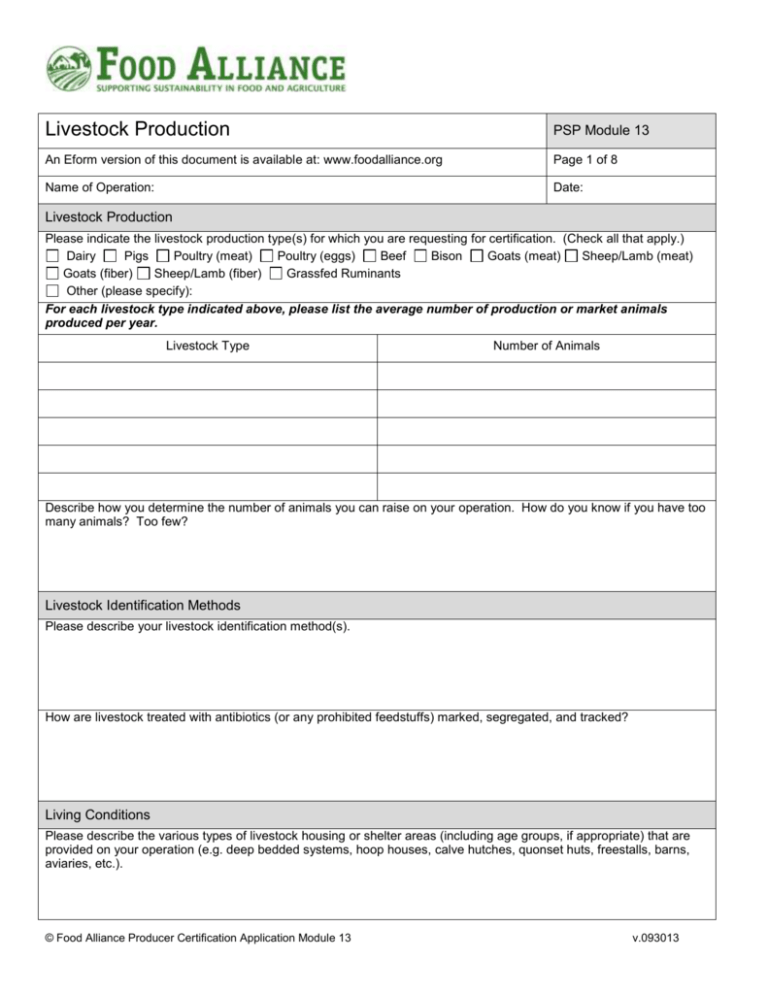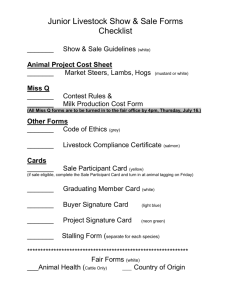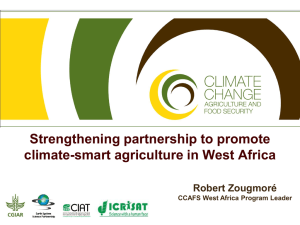Module 13: Livestock Production
advertisement

Livestock Production PSP Module 13 An Eform version of this document is available at: www.foodalliance.org Page 1 of 8 Name of Operation: Date: Livestock Production Please indicate the livestock production type(s) for which you are requesting for certification. (Check all that apply.) Dairy Pigs Poultry (meat) Poultry (eggs) Beef Bison Goats (meat) Sheep/Lamb (meat) Goats (fiber) Sheep/Lamb (fiber) Grassfed Ruminants Other (please specify): For each livestock type indicated above, please list the average number of production or market animals produced per year. Livestock Type Number of Animals Describe how you determine the number of animals you can raise on your operation. How do you know if you have too many animals? Too few? Livestock Identification Methods Please describe your livestock identification method(s). How are livestock treated with antibiotics (or any prohibited feedstuffs) marked, segregated, and tracked? Living Conditions Please describe the various types of livestock housing or shelter areas (including age groups, if appropriate) that are provided on your operation (e.g. deep bedded systems, hoop houses, calve hutches, quonset huts, freestalls, barns, aviaries, etc.). © Food Alliance Producer Certification Application Module 13 v.093013 Do livestock spend any part of the year in a confined feeding situation? (Please note confinement includes feed lots, confined winter feeding areas, loafing sheds, free stall barns, hoop houses, indoor poultry facilities and the like.) Yes No If no, please skip to next section – animal health & nutrition What types of bedding material(s) or litter do you use in indoor housing or other confinement areas? Please indicate reason animals are confined. (Check all that apply.) Inclement weather Animals’ stage of life Conditions under which the health, safety, or wellbeing of the animal could be jeopardized Risk to soil or water quality Preventive healthcare procedures or for the treatment of illness or injury Sorting or shipping animals and livestock sales Breeding Dry off/end of lactation Parturition Shearing Finishing Other (please specify): Please elaborate on the conditions or situation of any of the confinement periods selected above: (i.e. weather conditions, why animals’ health or safety may be at risk, etc.) Animal Health & Nutrition Describe common animal health problems and how often they occur. How do you prevent the health problems identified above from occurring? (Check all that apply.) Dry and clean living conditions Monitoring of nutrition Isolation of sick animals Pasture/outdoor area rotation Living area rotations Selective breeding Bio-security for the farm/ranch. Cleaning of living areas between groups Sanitation, using materials, of living areas between groups Other (please specify): How do you maintain health & welfare of animals? © Food Alliance Producer Certification Application Module 13 v.093013 What are you doing to improve health & welfare of animals? How is the health of animals evaluated? (Check all that apply.) Body condition scoring Physical characteristics Testing What testing is done? Production Visual assessment Behavior Other (please specify): What is the average culling rate for your herd/flock per year? What are the reasons animals are culled from the herd/flock? What is the average death rate for your herd/flock per year? Who is responsible for administering health treatments? Where are health materials stored on the operation? Is a veterinarian part of your health management system? Yes No If yes, please describe your veterinarian services (frequency of visits, for what purpose, etc.): Are written health records maintained to document treatments made on your animals? Yes No If Yes, please indicate if your health records include the following information: Individual animal ID Group ID Materials used Reasons for use Duration of use Other (please specify): © Food Alliance Producer Certification Application Module 13 v.093013 Are antibiotics used in your livestock operation? If yes, when? Name of Antibiotic Yes No Average number of animals treated per year Age at which animals are treated Reason for treatment If antibiotics are used, please complete this table. What preventative measures are taken to prevent external and internal parasites? Please list any products used to treat external or internal parasites. What preventative measures are used to control other animal pests, such as flies & gnats controlled? Please list any products used to treat flies & gnats. If animal feed is stored on-farm, please describe where it is stored & measures taken to prevent spoilage or contamination from rodents, birds, insects, etc. © Food Alliance Producer Certification Application Module 13 v.093013 Biosecurity & Hazard Reduction Which of the following practices are used to protect your herd/flock from introduced pathogens from off the farm? (Check all that apply.) Closed herd Testing/quarantine of new animals brought to the operation Testing/quarantine of animals taken off the operation and brought back home Rodent control Controlled visitor access Bleach/sanitizing stomp pads Other (please specify): How are carcasses disposed? (Check all that apply.) Burial Composting Incineration Removed through professional services Other (please specify): Ruminant Animals – Grazing systems N/A - Not applicable. Not seeking certification on ruminant animals – move to “Manure/Nutrient Management” section. What are your philosophy and goals regarding grazing management on your operation? What is the average beginning and ending dates of your grazing season? Do you supplement grazing with other feed? If so, please indicate the type of feed, time of the year feed is supplemented, and for how many months? Which best describes your grazing plan (in terms of planning for frequency of rotations, pasture/range health, etc.). Written & well-documented Partially written and/or documented Developed, but not written down How often is your grazing plan updated? What is done on your operation to minimize grazing on growing grass and/or plants too soon? What methods do you use to monitor the health of your pasture/rangeland? How often is monitoring conducted? Do animals have access to riparian or buffer areas? If so, how is access controlled? © Food Alliance Producer Certification Application Module 13 Yes No v.093013 Describe livestock watering systems in pastures or rangelands and how they are maintained. Are all grazing areas under your direct management? Yes No If no, describe the arrangements you have made to ensure all grazing management and livestock handling meets certification requirements: Are market animals finished in a yard, pen, or feedlot? Yes No (If no, move to next section – manure/nutrient management)) Please provide a description of the finishing area and where it is located. Manure and Nutrient Management Do you have a written nutrient management plan? Yes No If you are required to have a CAFO permit under the EPA Concentrated Animal Feeding Operation Rules, is it current and in good standing? Yes No N/A – not applicable. Do you have any permanent manure storage structures? Yes No If yes, please describe: How do you ensure manure is distributed at agronomic levels on your operation? Grazing management Store & apply manure at agronomic rates Manure is exported from the operation Other (please specify): If you use manure application equipment, please describe what type and how often it is calibrated. How do you manage manure accumulation at feeding/watering/shelter sites? Grazing management Feed/water/shelter sites are movable Manure is frequently loaded & hauled away Other (please specify): Animal Welfare, Humane Care, and Animal Handling How do you provide for your animals’ need to exhibit natural behavior patterns and physical activity? © Food Alliance Producer Certification Application Module 13 v.093013 Please comment on the demeanor of your animals when you handle them, and describe your approach to handling and working with them. Please list any trainings, workshops, or readings on low-stress handling techniques you or other animal handlers have completed. Please indicate which of the following describes your handling facilities. (Check all that apply.) Old and in need of repair Old, but retrofitted to meet animal welfare needs New and/or low-stress design Other (please specify): Please indicate which of the following physical alterations are performed, with what method, at what age they are performed, and pain prevention methods which are used. Pain prevention or pain Alteration Method Age Performed management agent used? Dehorning Yes No Castration Yes No Hoof/Toe Trimming Yes No Beak Trimming Yes No Tooth Filing Yes No Tail Docking Yes No Yes No Other (please specify): If yes was chosen above for pain prevention methods used, please describe those practices. When do you plan calving/lambing/farrowing each year and why do you plan it for this time? What is done to minimize stress and optimize health of animals when the following activities occur: Calving/lambing/farrowing: Weaning: © Food Alliance Producer Certification Application Module 13 v.093013 During severe weather: During transportation: When vaccinating/giving medical care: On-Farm/Ranch Casualty Euthanasia Please describe your methods for performing on-farm euthanasia of sick or casualty animals or for de-populating flocks: Please describe guidelines for deciding when a casualty animal should be treated versus euthanized. Please describe what physical signs you look for to confirm animals are rendered insensible during on-farm euthanasia: Transportation Please describe how livestock are loaded for transport, and by whom, during: On farm/ranch transport (to different grazing areas, housing facilities, etc.) Off-farm/ranch transport (to another operation, feedlot, or slaughter facility) What is the longest distance livestock are transported (hrs and miles)? If over 12 hours in transportation are the animals rested and fed? Yes No N/A – not applicable Livestock for Slaughter If animals are being raised for meat, are they slaughtered or processed on farm? If no, please list where slaughter and/or processing takes place: Yes No N/A At what point do livestock leave your ownership? © Food Alliance Producer Certification Application Module 13 v.093013 If retaining ownership, where is slaughter performed? © Food Alliance Producer Certification Application Module 13 v.093013





